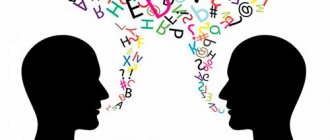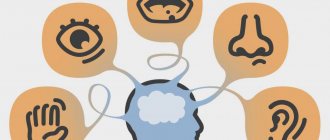Updated July 23, 2021 549 Author: Dmitry Petrov
Hello, dear readers of the KtoNaNovenkogo.ru blog. Each of us has a general idea of what speech is. However, there are significant differences in the understanding of this word by different people.
Even in dictionary interpretations, this phenomenon is referred to either as the activity of the speaker, or as a form of communication, or in general as a person’s psychological ability to express thoughts.
Today we’ll talk about how linguists understand speech, what types and functions they distinguish. Finally, let's figure out what the border is between language and speech.
Speech is...
In the scientific world there is rarely a unified meaning for such voluminous concepts as speech. However, the interpretation of Nina Davidovna Arutyunova, one of the most famous linguists of our time, is recognized by the majority of linguists. It sounds like this:
Speech is specific speaking that occurs in audio (including internal pronunciation) or written form.
In Ushakov’s Explanatory Dictionary, the first meaning is given as follows:
Speech is the ability to use the language of words. Speech is one of the characteristics that distinguishes humans from animals.
Both are true. But from the point of view of the science of language (and the logic of naming), N.D. Arutyunova’s definition will be primary. In the dictionary entry, she indicates that speech should be understood :
- speech activity as the process of speaking;
- speech productions (memorized or recorded) as a result of this process.
Other meanings of the term are derivative. For example, there is an understanding of speech as a style of language (artistic, business), as a public speech (greeting), as the nature of pronunciation (unintelligible).
Theories
During the entire period of formation and development of the ability, various theories have been put forward regarding this communicative tool. Modern scientists supported constructivist, relativist, preformist theory.
Preformist
Preformist theory was proposed by N. Chomsky in 1968. The scientist argued that different languages of the world have a similar structure. The opinion of preformationists agree that the human brain contains an initial structure that is determined by heredity.
Therefore, a person can change the meaning of phrases, understand their meaning, and construct meaningful statements, the number of which is unlimited.
At the same time, preformists do not deny that the development potential of a child depends on his environment, interactions with loved ones, the use of upbringing and teaching methods (parents, kindergarten, school, various educational institutions).
Constructivist
Constructivist theory is popular among researchers. According to it, the formation and development of the ability depends on the child’s inherent ability to process and perceive information from birth. A confirming example of this theory is spontaneous word creation in children at an early age. It is believed that children's first words are related to facts that they already understand. In addition, they can speak out about what interests them. Motivation has a huge impact on the formation of ability.
Relativistic
Another popular theory is relativistic. According to it, different languages can be considered from the perspective of the culture of the people, the nation. Each culture has different ways of constructing language. Many scientists are confident that the general picture of worldview depends on the language a person speaks, but when studying the linguistic characteristics of different nationalities of the world, this statement was refuted.
Types of speech
Even in elementary school, we learn that speech can be oral and written . But for linguistics this distribution is not enough.
It is customary to distinguish types of speech according to three main characteristics. Depending on these grounds, the basic classifications presented below have been formed.
By type of communication means used
Depending on how a person expresses his thoughts, speech is divided into the following types:
- Verbal . The main means of communication is the word (lat. Verbum).
- Nonverbal speech. Body language (facial expressions, gestures) and extralinguistic techniques (intonation, use of pauses, volume changes) are used.
- Oral . Involves speaking in audible form and understanding what is said by ear. Requires direct contact or mediation through a technical means (telephone, audio recording...).
- Written. Communication using a system of symbols that are depicted on a material medium.
- Kinetic . Transmitting thoughts using a system of signs that are associated with different finger configurations. This is the main way for communication between people deprived of the ability to hear and speak.
- Iconic. Based on the use of other semiotic systems - more specific ones. Example - emoticons, Morse code, code of signals in the navy.
It is obvious that in each specific speaking different types of speech intersect, since they are not in opposition to each other.
The most stable “ combo ” is oral + verbal + non-verbal speech, since in conversation we use words, facial expressions, and gestures.
Written speech is also verbal, but the nonverbal component in it is often reduced to zero.
Cognitive mental processes
4.1. Memory. Mnemonic processes
Memory
(English memory) is
- “the ability of a living system to record the fact of interaction with the environment (external or internal), preserve the result of this interaction in the form of experience and use it in behavior” [, P. 79];
- the set of mental processes by which information is encoded/registered (receiving, processing, combining received information), stored (creating a permanent record of encoded information), and retrieved/remembered (calling back stored information in response to an external or internal stimulus).
Rice.
4.1. Memory and mnemonic processes
All processes occurring in memory are called mnemonic
(from Greek memory).
Mnemonic activity
is the activity of memorizing and reproducing information.
Basic memory functions:
- reflective
- memory reflects objects that were previously felt and perceived by the subject through the creation of mnemonic images; - Regulatory
- memory is involved in all ongoing mental processes and acts as the basis of activity and behavior.
Physiological basis
memory – formation, preservation and updating of associations, i.e. temporary connections and their systems in the brain. The formation of associations occurs when stimuli affect the senses and there is attention to them. In the receptor systems of the analyzers, sensory traces of information appear; excess (repetitive) information is filtered out by the thalamus. Incoming information is structured in the sensory cortex (the beginning of the stage of short-term memory formation). The associative cortex determines which part of the received information will be transferred to long-term memory. The hippocampus (part of the limbic system of the brain) is involved in the mechanisms of memory consolidation - transferring information from short-term memory to long-term memory, selectively enhancing the memorization of objects.
Basic mnemonic processes:
- Memorization (coding)
is the process of imprinting sensory traces of information in a system of associations;
“transformation of information into a specific code or representation acceptable for memory” [, P. 293]. Memorization is selective. The process of memorization can proceed as an instantaneous imprinting - imprinting
. - Storage
is the process of retaining and processing encoded information. - Reproduction
is the process of retrieving information stored in memory. Reproduction can be carried out at the level of recognition, at the level of reproduction and at the level of recall. - Forgetting
is an active process consisting in the loss of access to stored information, the inability to reproduce or learn what has been learned.
R. Atkinson and R. Shifrin [] proposed the following memory model (Fig. 4.2).
Rice.
4.2. Atkinson-Shifrin memory model
The data to be stored is called memory
, and the structural element in which they are stored is
a memory storage
. The incoming stimulus is registered in sensory memory. Information held in the sensory register for 1-3 seconds is scanned, and the filtered part of it is entered into short-term storage. Long-term storage receives information from short-term storage and also directly from sensory memory. Information located in long-term storage is relatively permanent, although access to it may be lost due to interference with input information.
Memory Specifications:
- Duration
is the time during which the necessary information is retained in memory. - Volume
– the number of elements simultaneously retained in memory (the volume of short-term memory is limited to 7 ± 2 elements; the volume and duration of storage in long-term memory is practically unlimited). - Reproduction accuracy
is the degree of correspondence between the received information and the one reproduced from memory (in percentage). - Reproduction speed
is the speed of retrieving the necessary information from memory. - Memorization speed
is the speed of imprinting information per unit of time, depending on the number of repetitions. - The rate of forgetting
is the speed at which information (memory capacity elements) disappear from memory per unit of time.
In Fig. 4.3 shows the main characteristics of memory components given in the work of R. L. Solso [, P. 272].
Rice.
4.3. Characteristics of components of cognitive storage systems
Approaches to classification of types of memory
1. Based on the nature of mental activity, the following types of memory are distinguished:
- figurative
– information is remembered in the form of sensory-perceptual images of a certain modality (visual, auditory, tactile, olfactory, gustatory) and is used to satisfy biological needs and needs related to the safety / self-preservation of the body. - emotional
– memory of experienced affects, emotions, feelings and moods; - motor (motor)
– memory of various characteristics of movement (amplitude, speed, tempo, rhythm, sequence, etc.); is largely automated; serves as the basis for the formation of walking, writing, labor and other skills, and also underlies speech. - verbal-logical
– memory for numbers, words, concepts, rules, abstract ideas.
2. By duration of information storage
distinguish instant (synonyms - iconic, sensory, trace), short-term, long-term and operational memory.
RAM
includes elements of short-term and long-term memory that are updated to perform a specific operation (action, activity) over a certain period of time (from several tens of seconds to several days).
3. According to the degree of volitional control
types of memory are distinguished:
- voluntary memory
– volitional regulation of mnemonic activity aimed at achieving a conscious mnemonic goal (task); - involuntary memory
– there is no special mnemonic task (goal) and memorization occurs automatically and without volitional effort.
4. By learning method
There are two types of memory:
- mechanical memory
- memorizing perceived information without analyzing and transforming it through repeated repetitions; - logical memory
– remembering information by identifying and structuring logical connections and relationships between individual elements.
Logical memory is many times more productive than mechanical memory.
5. On the use of aids
There are two types of memory:
direct (natural)
- memory without the use of auxiliary means, and
indirect
- using various means and techniques.
6. By origin
There are types of memory:
genetic (biological
), determined by the genotype and transmitted from generation to generation, and
acquired
, storing information that a person learns during life.
7. According to the degree of awareness
distinguish between
implicit
(unconscious) and
explicit
(conscious) memory.
Mnemonics
– a system of techniques to increase the efficiency of memorizing information: to increase the amount of information memorized after a single presentation, as well as the speed, accuracy and speed of memorization.
Techniques for improving the process of memorizing information:
- control of voluntary and post-voluntary attention;
- structuring information using various methods (ranking, sorting, classification, etc.)
- rational repetition;
- use of semantic techniques;
- purposeful imagination.
Memory disorders (anomalies):
- hypomnesia
– weakening of memory; - paramnesia
– false recognition of unfamiliar objects (“déjà vu”); - amnesia
– absence or significant decrease in memory; - hypermnesia
is a sharp increase in mnemonic processes of memorization, storage and reproduction.
Types of speech based on discontinuity and continuity
- Dialogical speech is realized during the communication of several interlocutors (two or more). It is discontinuous, as it implies a direct reaction, the inclusion of comments, evaluations, and additions.
- Monologue However, it is implemented by one speaker, it does not have pauses for the inclusion of remarks from the interlocutors.
These types can be actualized both in oral and written communication.
By type of social processes
The definition emphasized that internal enunciation is a form of speech along with voicing. Therefore, the following classification is relevant:
- External . Aimed at communication between people.
- Internal . It is updated in a person’s consciousness or unconsciously.
Speech and thinking are directly related. The process of transforming thoughts into words and words into thoughts is based on the phenomenon of inner speech .
It is necessary to describe specific speaking taking into account all classifications. For example, the correspondence of two VK friends is external, dialogic, verbal, non-verbal sign (if emoticons are used) speech.
Monologue and dialogue. Examples and essence of concepts
Classification of speech according to the number of participants was undertaken in ancient times. The division into dialogues and monologues was used in such areas as logic, rhetoric, and philosophy. The term “polylogue” arose at the end of the 20th century and refers to a conversation involving more than two people.
A form such as dialogue is characterized by alternating statements from both interlocutors in direct connection with a specific situation. The statements themselves are called replicas. In terms of semantic load, dialogue is an exchange of opinions that depend on each other.
The entire dialogue and any of its parts can be perceived as a separate textual act. The structure of a dialogue includes parts called beginning, base and ending. The first of these uses generally accepted forms of speech etiquette, a greeting or an introductory remark in the form of a question or judgment.
Functions of speech
There are 4 main functions of speech:
- Communicative . Associated with communication between people and the transfer of information. It has internal divisions shown below.
- Cognitive. It is the main mechanism for accumulating human knowledge and transferring it to new generations.
- Psychodiagnostic . By observing the speaking process, the interlocutor understands the state of the speaker and can create a portrait of his personality.
- Psychotherapeutic. Involves the ability to verbally support another person.
The communicative function has 4 aspects (what is it?):
- Organizational . Conversation is used to agree on common actions.
- Expressive. An antisocial state and reaction are expressed and emphasis is placed.
- Incentive . Implies a request, order, persuasion.
- Marking . A person’s characterization of everything that surrounds him, for orientation in space, for the transfer of experience or his assessment to others.
Construction and playback stages
There are several stages of speech construction:
- Formation of thoughts and statements.
- Construction of inner speech. At this stage, the individual thinks about how to convey the idea to the interlocutor.
- Selecting individual or related phrases, assumptions, forming beliefs.
- Selecting individual words, morphemes, composing complete sentences.
The last stage is reproduction of the generated text. For this, different sound signals are used. Speech is supplemented by facial expressions, gestures, changes in tempo, timbre and tone of voice, and emphasis on individual words.
Study methods
To study abilities, psychologists and linguists use different methods:
- Observation. The total time spent on conversations with others and monologues, gestures, facial expressions, changes in tone, tempo, and expressiveness is taken into account. When observing, natural thinking is maintained, which is a huge advantage.
- Conversation. An effective method for studying ability. With its help, you can find out the interlocutor’s attitude to the assigned task, evaluate mental capabilities, and learn language skills. During the conversation, direct or indirect questions may be asked.
- Experiment. Researchers create conditions for the subject and change them to obtain information. Additionally, data on brain function can be read using specialized equipment.
- Questioning. Used to study thinking. Questionnaires are prepared in advance, questions are selected on one or more topics of interest. A detailed result is given by open-ended questionnaires that force the subject to activate his thinking.
- Testing. Allows you to measure the level of intellectual development and find out the features of thinking.
Researchers analyze the data obtained and draw conclusions.








